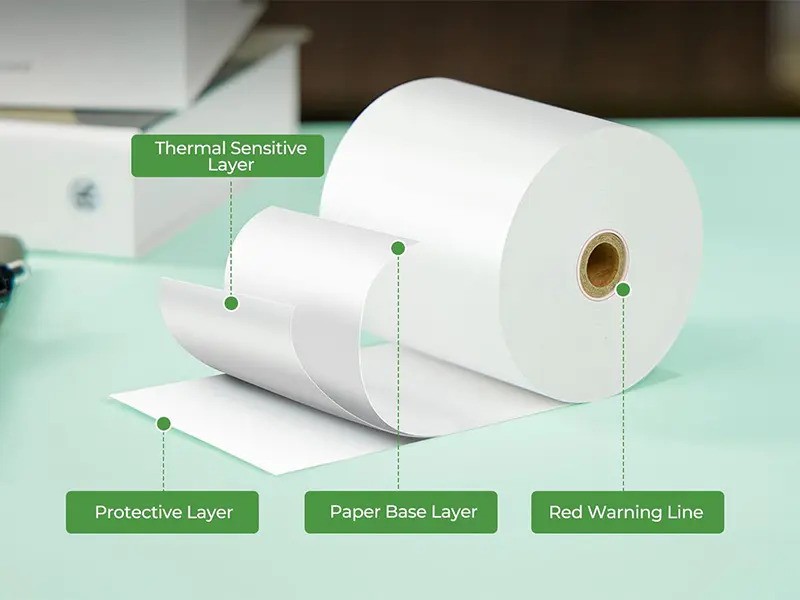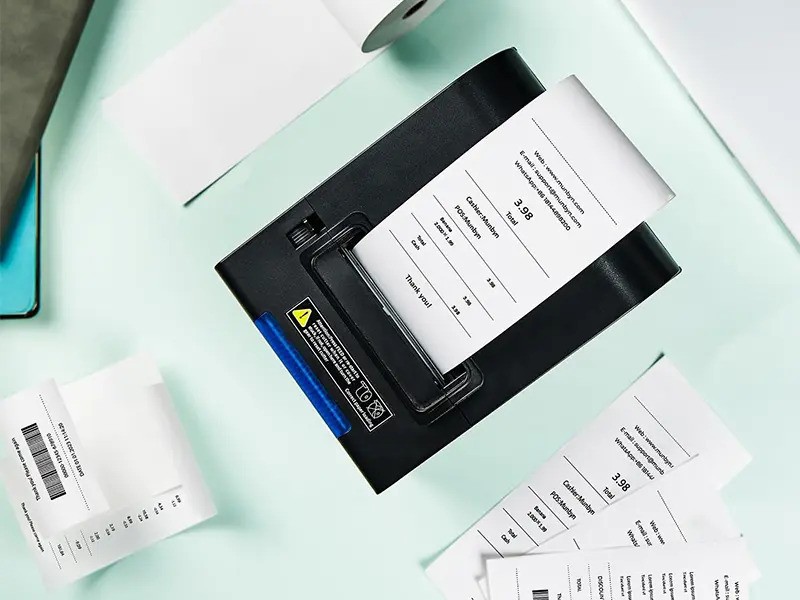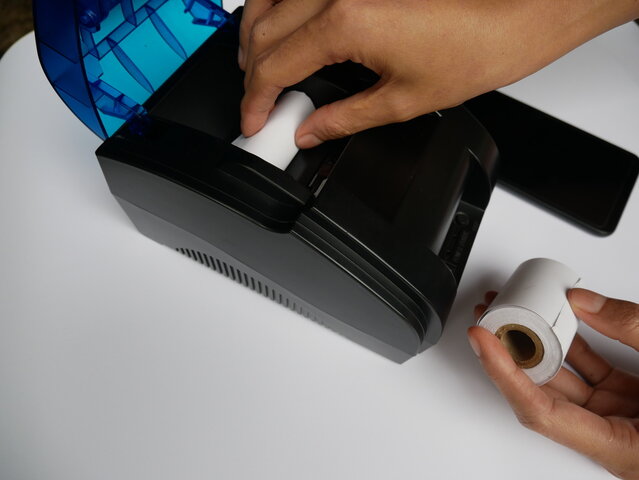
Ever noticed your important receipts fading away over time? It's not magic – it's chemistry.
Thermal paper contains special heat-sensitive chemicals that create images without ink.
When exposed to heat, light, or moisture, these chemicals break down.
This special paper is everywhere in our daily lives. Receipts, tickets, labels, and medical charts all use thermal paper technology.
Without proper storage, critical information can disappear completely.
The chemical coating that makes thermal printing possible is also its greatest weakness.
In this post, you'll learn why thermal paper fades, and the best ways to store and protect it for long-term use.
Why Does Thermal Paper Fade?
Thermal paper is widely used for receipts, labels, and tickets, but its biggest drawback is fading over time. This occurs due to chemical breakdown, environmental exposure, and improper handling.
Key Takeaways
✔ Thermal paper fades due to chemical breakdown, heat, light, moisture, and handling mistakes.
✔ UV light and high temperatures accelerate fading, making proper storage essential.
✔ Contaminants like oils, cleaning chemicals, and adhesives can react with the coating, causing prints to disappear.
✔ Best storage methods: Keep paper in airtight, dark, and cool environments to preserve print quality.
Chemical Composition of Thermal Paper
Thermal paper contains a heat-sensitive chemical coating that darkens when exposed to heat. The key components in this coating determine its print quality and longevity.

Key Chemical Components
| Component | Function | Effect on Fading |
| Leuco Dye | Reacts to heat to form images | Fades when exposed to air, heat, and light |
| Color Developer (BPA/BPS) | Helps activate the dye reaction | Breaks down under UV light |
| Sensitizer | Lowers activation temperature | May weaken over time |
| Protective Coating | Shields against moisture and contaminants | Wears off with handling |
How It Works:
When the paper passes through a thermal printer, the printhead heats specific areas, triggering a reaction between leuco dye and color developer, which creates the printed text or image.
Why It Fades: Over time, exposure to light, heat, and chemicals reverses this reaction, causing the printed areas to disappear.
Environmental Factors Affecting Fading
Several environmental conditions accelerate the fading of thermal paper:
1. Heat Exposure
High temperatures darken unprinted areas, making text harder to read.
Even prolonged storage in a warm environment can trigger unwanted color changes.
☀ 2. UV Light (Sunlight & Fluorescent Lights)
Breaks down the color developer, causing fading.
Direct sunlight and strong indoor lighting accelerate degradation.
Best Practice: Store in a dark, cool place to slow the fading process.
3. Humidity & Moisture
High humidity can soften the protective layer, allowing contaminants to alter the thermal coating.
Moisture can cause ink smudging or paper warping.
Ideal humidity level: 30%-50% for long-term storage.
4. Airborne Pollutants & Contaminants
Exposure to dust, oils, and airborne chemicals can alter the chemical coating, leading to uneven fading.
Office environments with high chemical exposure (such as cleaning products) can degrade receipts faster.
Chemical Reactions and Physical Handling
Certain substances and physical handling mistakes can accelerate fading.
Common Chemical Causes of Fading:
| Substance | Effect on Thermal Paper |
| Oils from Hands | Breaks down coating, causing uneven fading |
| Cleaning Fluids & Solvents | Reacts with chemicals, erasing prints |
| Plasticizers (from plastic sleeves) | Causes chemical degradation, leading to fading |
| Ammonia & Carbonless Paper | Alters coating, reducing image clarity |
⚠ Handling Mistakes to Avoid:
❌ Applying Tape: Tape adhesives react with the coating, making text disappear.
❌ Storing with Carbonless Paper: Contact with carbonless paper speeds up fading.
❌ Frequent Folding & Scratching: Damages the thermal coating, leading to poor print retention.
Best Practice: Handle thermal paper with clean hands, avoid tape on printed areas, and store receipts separately from other documents.

How to Store Thermal Paper Properly
Storing thermal paper correctly is crucial to maintaining its print quality and extending its lifespan. Improper storage can lead to fading, discoloration, and unreadable prints. Below, we outline the best practices to keep thermal paper in optimal condition.
Key Takeaways
✔ Maintain 20-25°C temperature and 30-50% humidity for optimal storage.
✔ Keep paper away from direct light, especially UV and fluorescent lights.
✔ Store in airtight containers to prevent moisture, dust, and contaminants.
✔ Handle carefully—no folding, creasing, or touching with oily hands.
✔ Check expiration dates and use within 18 months for best print quality.
Avoid Direct Sunlight and UV Exposure
Sunlight and UV rays break down the thermal coating, causing receipts to fade faster.
✅ Best Practices:
Store receipts in a dark place such as a drawer, folder, or envelope.
Use lightproof storage containers for long-term preservation.
Keep receipts away from windows, fluorescent lights, and direct sun exposure.
⚠ Why It Matters:
| Light Source | Effect on Thermal Paper |
| Direct Sunlight (UV Rays) | Causes rapid fading and discoloration |
| Fluorescent Lights | Slowly degrades print quality |
| LED Lights | Minimal effect if stored properly |
Storage Tip: Use blackout storage bags or archival-grade folders to block UV exposure.
Control Temperature
Heat can cause thermal prints to darken or fade prematurely. Maintaining a stable temperature is crucial.
✅ Best Practices:
Store receipts in a cool location with temperatures between 68-77°F (20-25°C).
Avoid placing receipts near heat sources like radiators, stoves, or direct sunlight.
Never leave receipts in hot environments like cars, where temperatures can exceed 120°F (49°C).
Storage Tip: A temperature-controlled cabinet or climate-regulated storage room is ideal.
Maintain Proper Humidity Levels
High humidity weakens the thermal coating, while low humidity causes static buildup.
✅ Best Practices:
Maintain a relative humidity of 45-65% for optimal storage.
Use silica gel packs or dehumidifiers in humid environments.
Avoid storing receipts in damp areas like basements or bathrooms.
Storage Tip: Place silica gel packets inside storage boxes to absorb excess moisture.
Minimize Contact and Handling
Frequent handling can transfer oils, dirt, and contaminants, leading to faster fading.
✅ Best Practices:
Handle receipts by the edges to prevent skin oils from damaging the thermal coating.
Use gloves or tweezers when handling sensitive documents.
Avoid frequent folding, crumpling, or rubbing against other surfaces.
Storage Tip: Keep important receipts inside protective folders to reduce direct handling.
Store in Appropriate Containers
Choosing the right storage materials helps protect receipts from environmental damage.
✅ Best Storage Options:
✔ Acid-free boxes, folders, or envelopes to prevent chemical reactions.
✔ Archival-grade storage materials for valuable receipts.
✔ Plastic-free storage bags to reduce chemical exposure.
❌ What to Avoid:
PVC plastic sleeves – they release chemicals that react with thermal paper.
Cardboard boxes – may contain acids that accelerate fading.
Cheap plastic bags – can trap moisture, leading to smudging.
Storage Tip: Use polyester-based sleeves instead of PVC plastic for long-term preservation.
Keep Away from Chemicals and Moisture
Thermal paper reacts negatively to chemicals, oils, and solvents, leading to blurred or erased text.
✅ Best Practices:
Keep receipts away from cleaning supplies, perfumes, and office chemicals.
Avoid storing them near food, drinks, or plants that can introduce moisture.
Immediately address water leaks or spills near stored receipts.
Storage Tip: Store receipts in a dedicated, chemical-free storage space to avoid exposure.
Digitize Important Receipts
Digital backups ensure you never lose critical financial records due to fading.
✅ Best Practices:
Scan or photograph receipts for long-term record-keeping.
Store digital copies in cloud storage, external drives, or document management apps.
Keep both physical and digital copies of receipts related to warranties, taxes, or legal documents.
Storage Tip: Use apps like Adobe Scan, CamScanner, or Tabscanner for easy receipt digitization.
How to Restore Faded Thermal Paper
Faded thermal paper can be frustrating, especially when dealing with important receipts, invoices, or warranty documents. While thermal paper degradation is irreversible, several methods can partially restore faded text. Below are practical techniques to enhance readability.
Scanning & Digital Restoration
Digital restoration is the safest and most reliable method for recovering faded thermal paper text.
Scan the receipt using a high-resolution scanner (300+ DPI)
Use photo editing software like Adobe Photoshop or free alternatives
Create a negative image by inverting colors
Adjust levels including brightness, contrast, and saturation
Sharpen the image to enhance text visibility
Pro Tip: If the receipt paper is still white (not yellowed or browned), scan it as a color image for better results when creating a negative.
Mobile apps specifically designed for receipt recovery can simplify this process:
Tabscanner
DocHub
LightX
PicsArt
Heat Application Method
Applying heat is a traditional method to attempt text restoration, but it carries risks.
✅ How to Apply Heat Correctly:
✔ Use a hairdryer on a low setting to gradually warm the receipt.
✔ Hold a light bulb over the backside of the paper for a few seconds.
✔ Observe changes and stop immediately if text begins to blur.
⚠ Heat Restoration Risks:
Warning: Never use an iron or open flame, as excessive heat destroys the paper completely.
UV Light Exposure
UV light exposure is an experimental method with mixed results.
| UV Light Type | Effectiveness | Required Exposure Time |
| UV-A (365nm) | Moderate | 5-15 minutes |
| UV-B (315nm) | Limited | Not recommended |
| UV-C (254nm) | Variable | 30-60 seconds (with caution) |
The process involves:
Acquiring a UV LED light source
Finding a dark environment
Exposing the faded receipt to UV light
Observing any text reappearance
This method's effectiveness varies widely depending on the thermal paper manufacturer, age, and storage conditions.
Chemical Treatment
Certain chemical solutions can partially restore faded thermal paper, but they must be used with caution.
✅ Potential Chemical Solutions:
Ethanol (Alcohol) – Enhances contrast by dissolving surface contaminants.
Citric Acid (Lemon Juice) – Can slightly darken faded text.
Vinegar or Ammonia – May reactivate the thermal coating.
⚠ Risks of Chemical Restoration:
Can damage the paper permanently if applied too aggressively.
May erase text instead of restoring it.
Always test on a small section first.
⚠️ Important: Chemical treatments can make paper brittle or cause discoloration. Always test first and proceed with extreme caution.
Professional Restoration & Alternatives
If the above methods fail, consider professional or alternative solutions.
✅ Best Professional Restoration Methods:
✔ Consult document restoration specialists for high-value receipts.
✔ Contact the original vendor to request a reprinted receipt.
✔ Use laser engraving machines to retrace faint text.
Alternative Solution: Digital Backup
Instead of restoring every faded receipt, digitize your documents early:
| Method | Benefit |
| Scanning receipts | Prevents loss due to fading |
| Cloud storage backups | Ensures accessibility from any device |
| Printed copies | Physical backup in case of digital failure |
Tip: If restoration is impossible, keeping a digital backup from the start is the best long-term solution.

Choosing Quality Thermal Paper for Your Business
Selecting the right thermal paper significantly impacts your business operations, document longevity, and customer experience. Not all thermal paper is created equal, and making informed choices can save you headaches down the road.
Opt for Higher-Grade Thermal Paper Rolls Designed for Archivability
Higher-grade thermal paper offers superior longevity and image stability:
Enhanced image life: Premium papers maintain legibility for 5-7 years versus 18 months for standard paper
Better resistance: Higher-grade papers withstand environmental challenges more effectively
Improved print quality: Smoother surfaces create sharper, more professional-looking text and images
While premium thermal paper costs more initially, the extended lifespan often justifies the investment, especially for important business records.
Look for Thermal Paper Treated with Protective Topcoatings
Protective topcoatings significantly extend thermal paper life:
| Coating Type | Benefits | Best For |
| Standard | Basic protection | Short-term receipts |
| Enhanced | Improved water/oil resistance | Restaurants, retail |
| Premium | Maximum environmental protection | Legal documents, warranties |
The best topcoatings shield the thermal layer from moisture, UV light, and chemical exposure—the primary causes of premature fading.
Consider Non-Phenol Thermal Paper Options
Traditional thermal papers often contain potentially harmful chemicals:
Health & Environmental Consideration: Many businesses now choose BPA-free and BPS-free thermal papers to protect employee health and reduce environmental impact.
Non-phenol alternatives use different chemical developers that:
Reduce handling risks for cashiers and customers
Comply with stricter regulations in many jurisdictions
Often provide comparable or superior image stability
Choose Reputable Thermal Paper Suppliers with Consistent Quality
Your supplier choice directly impacts paper performance and reliability:
Work with established vendors who specialize in thermal products
Request sample rolls to test before bulk purchasing
Check for consistent quality across batches
Verify storage conditions at the supplier facility
Inquire about manufacturing dates and shelf life
Quality suppliers will provide detailed specifications about their thermal paper, including recommended storage conditions, expected image life, and chemical composition.
Conclusion
Thermal paper fades over time, but proper storage extends its lifespan. Keep receipts away from heat, light, and moisture for better preservation.
Use airtight containers, archival-grade paper, and protective coatings to reduce fading. Handling with clean hands or gloves prevents oil damage.
Digitizing receipts ensures permanent record-keeping and protects against loss. Choosing high-quality thermal paper improves print durability.
FAQs About Thermal Paper Fading & Storage
Q: How long will thermal paper last if stored properly?
A: High-quality thermal paper can last 5 to 7 years if stored in a cool, dark, and dry environment with humidity between 30%-50%.
Q: Can you laminate thermal paper receipts?
A: No, laminating can darken thermal paper due to heat. Instead, store receipts in acid-free envelopes or scan them for digital backup.
Q: What's the best way to organize and store receipts?
A: Store receipts in lightproof, airtight containers or acid-free folders. Keep them in a cool, dry place away from sunlight and heat.
Q: Are there any apps to help track receipts?
A: Yes, apps like Expensify, Receipt Bank, Shoeboxed, and Adobe Scan can help track, digitize, and organize receipts efficiently.
Q: Is it safer to get email/e-receipts instead?
A: Yes, email/e-receipts are safer as they don't fade and can be stored securely in the cloud for long-term record-keeping.
Q: How can you prove purchases if a receipt is too faded to read?
A: Use credit card statements, bank records, warranty registrations, or digital copies as proof of purchase if the receipt is unreadable.
Q: How to prevent thermal ink from fading?
A: Store thermal paper away from heat, light, and moisture. Use high-quality, top-coated thermal paper and avoid frequent handling.
Q: How to recover faded thermal paper?
A: Try scanning and digitally enhancing the image, gently heating the backside with a hairdryer, or using UV light exposure.
Q: How long does thermal paper last before it fades?
A: Standard thermal paper lasts 6-12 months, while archival-grade paper can last 5-7 years with proper storage.
Q: How to maintain thermal paper?
A: Store in airtight, acid-free containers, keep away from light and moisture, and avoid exposure to oils and solvents.
Q: How to fix thermal printer fading?
A: Clean the printhead regularly, use high-quality thermal paper, and ensure proper printer temperature settings for optimal printing.



























